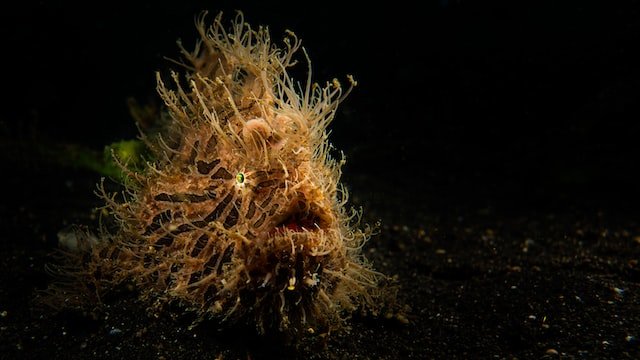THE 5 WEIRDEST UNDERWATER ANIMALS
Some ocean animals are pretty odd-looking, let’s face it. Here are five of the strangest underwater animals on our list.
Our tendency as divers is to think all fish are beautiful…but are they? In reality, some of them look so out of place that it makes you wonder what the hell went wrong with evolution. Among the weirdest underwater animals in the world, here are some of our favourites.
PSYCHEDELIC FROGFISH

Unlike other fish, frogfish have modified pectoral fins that enable them to move slowly on the seafloor. First described in 2009, the Psychedelic Frogfish is found only in Ambon, Indonesia.
The wild-looking frogfish is best described as psychedelic. This rare variety, as noted above, is more strange-looking than other relatives of the deep-sea anglerfish. A decade ago, scientists identified this species, and so far, it has only been found in Ambon, Indonesia. The swirling stripes on its body earned it its nickname, and divers who see one should definitely make it a point to visit one.
LEAFY SEADRAGON

The leafy seadragon (Phycodurus eques) is a marine fish that is native to the southern coast of Australia. They are closely related to seahorses and pipefishes, and like them, they belong to the family Syngnathidae.
Leafy seadragons are known for their unique and distinctive appearance, they have a long, thin body covered in leaf-like appendages that help them blend in with the seaweed and kelp that they inhabit. They are typically yellow, orange, or green in color and can grow up to 45 centimeters (18 inches) in length.
They are slow-moving creatures and use their camouflage to blend in with their surroundings while they wait for unsuspecting prey to swim by. They feed on small crustaceans such as mysids and plankton.
Leafy seadragons are considered to be a vulnerable species, their populations have been affected by habitat destruction and pollution, as well as overcollection for the aquarium trade. They are protected by law in Australia and international trade in leafy seadragons is regulated by the Convention on International Trade in Endangered Species of Wild Fauna and Flora (CITES).
Leafy seadragons are popular among divers and underwater photographers, as they are considered one of the most beautiful and unique marine creatures. They are not commonly found in the aquarium trade due to their specific habitat requirements and sensitivity to water quality.
MOLA MOLA

They are known for their large size, with some individuals growing up to 10 feet (3 meters) in length and weighing up to 5,000 pounds (2,268 kg). Mola molas can be found in all oceans around the world.
There are a number of differences between mola molas and other species of fish, including their distinctive body shape and small dorsal fin.
Slow-moving, they spend most of their time basking on the water’s surface.
In addition to jellyfish, squid, and small fish, these animals are opportunistic feeders.
In contrast to other fish species, they swim by using their dorsal fin to propel themselves forward.
Many of them live up to 50 years, making them long-lived.
Due to its unique appearance and peaceful behaviour, mola mola is popular among divers and snorkelers.
Commercial fishing overfishes and bycatch causes them to be considered a vulnerable species.
As mola mola control jellyfish populations, they play a crucial role in maintaining a healthy ocean ecosystem.
BOBBIT WORM

It has been voted the ugliest species in the ocean.
A marine polychaete worm, the Bobbit worm (Eunice aphroditois) inhabits tropical and subtropical waters of the Indo-Pacific region. Their bodies are long and slender and can grow up to 3 meters (10 feet) long. They hunt by burying themselves in the sand, leaving only their antennae exposed to sense prey. With its powerful jaws, the worm grabs an unsuspecting creature when it comes close. Nighttime is the most active time for bobbit worms because they are nocturnal hunters. They have a hard exoskeleton, which protects them from predators and allows them to burrow into the sand.
It is known that they are solitary creatures and that they do not form groups or schools. The marine aquarium trade considers bobbit worms a serious pest since they can consume all small fish quickly. Fish, crustaceans, and mollusks are among the foods they eat. They are opportunistic feeders. Bobbit worms help control the population of smaller organisms in the ocean ecosystem despite their fearsome reputation. The lifespan of these creatures is relatively short, lasting only a few years.
RHINOPIAS

Rhinopias is a genus of venomous marine fish that belongs to the scorpionfish family. They are also known as weedy scorpionfish or leaf scorpionfish. There are several species of Rhinopias found in tropical and subtropical waters of the Pacific and Indian Oceans, such as Rhinopias aphanes, Rhinopias eschmeyeri, Rhinopias frondosa, Rhinopias argoliba and Rhinopias xystus.
Rhinopias are known for their distinctive and unusual appearance, they have a flat, leaf-like body and a variety of colors and patterns that help them blend in with their surroundings. They are able to change their color and texture of the skin to match the surrounding environment. They are typically found in coral reefs and rocky outcrops.
They are ambush predators and use their camouflage to blend in with their surroundings while they wait for unsuspecting prey to swim by. They have venomous spines on their dorsal fins that can be used for self-defense and hunting.
Rhinopias are considered to be a rare and elusive species, and are highly prized by divers and underwater photographers for their unique and unusual appearance. They are not commonly found in the aquarium trade due to their venomous spines and demanding habitat requirements.
Rhinopias are not considered to be endangered, but some populations may be affected by habitat destruction and overfishing.
In the national park of Komodo you will be able to spot some of the considered ugliest species, and we are proud to have such a wide variety of marine creatures.

